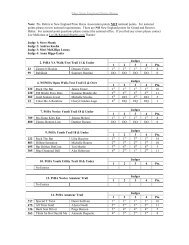2011 Official Rule Book - New England Pinto Horse Association
2011 Official Rule Book - New England Pinto Horse Association
2011 Official Rule Book - New England Pinto Horse Association
Create successful ePaper yourself
Turn your PDF publications into a flip-book with our unique Google optimized e-Paper software.
c. Jump heights will be increased not less than three (3)<br />
inches and no more than six (6) inches in height for<br />
each jump-off round.<br />
d. The <strong>Pinto</strong> with the fewest faults will be declared the<br />
winner.<br />
e. Number of jumps to be raised is at the discretion of the<br />
judge.<br />
f. When jump height reaches 34”, exhibitors will be<br />
timed on the course and those times will be used to<br />
determine the placings if there are ties in the number<br />
of faults.<br />
3. Scoring<br />
a. In scoring Jumpers, an in-and-out is to be considered<br />
as two jumps. Jumpers are scored on a mathematical<br />
basis and penalty faults, include knockdowns and<br />
refusals as follows:<br />
(1) Knockdowns— 4 faults. An obstacle is considered<br />
knocked down when, in jumping an obstacle,<br />
a <strong>Pinto</strong> or exhibitor, by contact, lowers the<br />
established height of the fence in any way.<br />
(2) Refusals – 3 faults. Stopping at an obstacle<br />
without knocking it down and without backing,<br />
followed by jumping from a standstill is not<br />
penalized. However, if the halt continues or if the<br />
<strong>Pinto</strong> backs even a single step, side steps, or<br />
circles to retake the fence, a refusal is incurred.<br />
(3) Circling after crossing starting line – 3 faults.<br />
Any form of circle or circles whereby the <strong>Pinto</strong><br />
crosses its original track between two consecutive<br />
obstacles or stops advancing toward or turns<br />
away from the next fence except to retake an<br />
obstacle after a disobedience.<br />
(4) Crossing your own path (as in circling between<br />
fences, not as in retaking a fence from a refusal)<br />
– 3 faults. A <strong>Pinto</strong> that has been penalized for<br />
circling cannot then be penalized again for<br />
crossing its own path at the same obstacle.<br />
b. Elimination<br />
(1) Three (3) refusals<br />
(2) Off course<br />
(3) Fall of <strong>Pinto</strong> and/or exhibitor.<br />
4. Tack and Attire<br />
a. Whips are permitted but shall not be used to<br />
encourage the <strong>Pinto</strong> to jump.<br />
b. Exhibitor foot wear is optional<br />
c. Front leg wraps and boots are optional.<br />
d. A plain leather halter is to be used.<br />
E. Hunter Class<br />
1. Hunter Course Design<br />
a. Hunters are to be judged on style, manners, and way<br />
of going with preference given to those <strong>Pinto</strong>s who<br />
cover the course at an even pace, with free flowing<br />
strides, as in a brisk trot or canter, but must maintain<br />
same gait throughout course.<br />
b. Sample courses to be provided to show management.<br />
c. Jumps must be a minimum height of eighteen (18)<br />
inches and maximum of twenty-four (24) inches.<br />
d. There will be a minimum of four (4) obstacles, and<br />
<strong>Pinto</strong>s are to make a minimum of six (6) jumps and a<br />
maximum of eight (8) jumps.<br />
e. Jumps must simulate those found in the hunting field,<br />
such as brush, stone wall, gate, white fence, chicken<br />
coop, oxer, and in-and-out.<br />
<strong>2011</strong> PtHA <strong>Rule</strong> <strong>Book</strong> 169<br />
ClassEs



